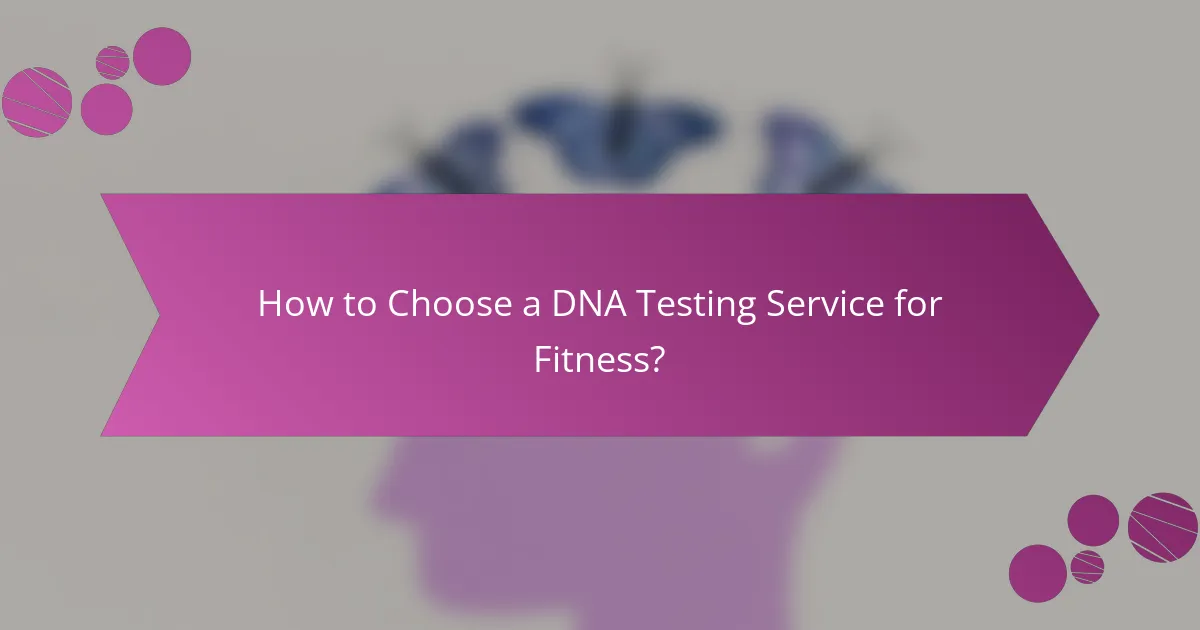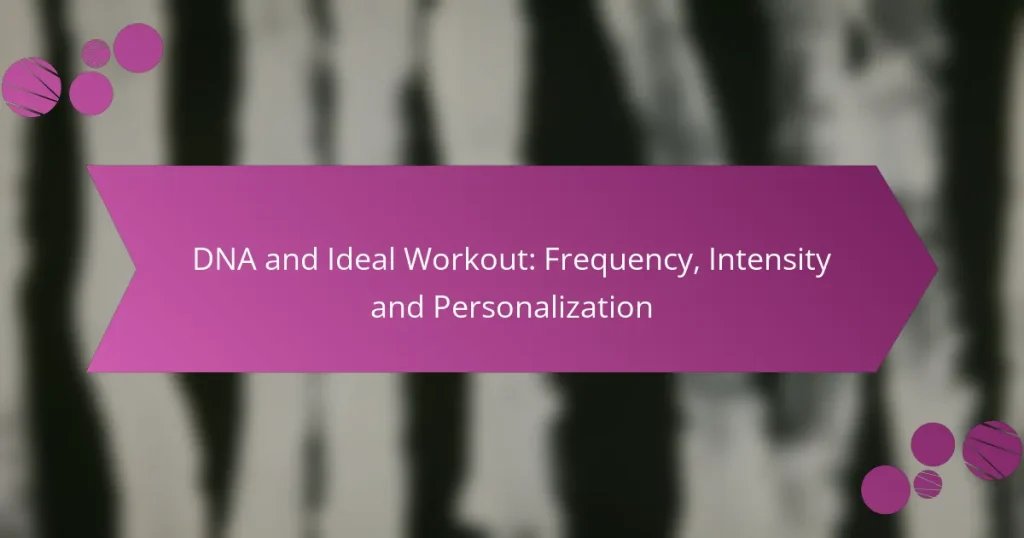Understanding the interplay between DNA and exercise can significantly enhance your fitness journey. Genetic factors influence not only the optimal frequency and intensity of workouts but also how your body responds to different regimens. By personalizing your workout routine based on genetic insights, you can optimize performance, improve recovery, and minimize the risk of injury.

How Does DNA Influence Workout Frequency?
DNA plays a significant role in determining how often individuals should work out. Genetic factors can influence not only the optimal frequency of exercise but also how one’s body responds to different workout regimens.
Genetic predisposition to exercise frequency
Some individuals have a genetic predisposition that affects their ideal workout frequency. For instance, certain genes are linked to muscle recovery and endurance, which can dictate how often one can effectively train without risking injury or burnout. People with a higher genetic tolerance for exercise may thrive on more frequent sessions, while others may need more recovery time.
Research suggests that variations in genes such as ACTN3 can influence muscle performance and recovery, impacting how often a person should engage in high-intensity workouts. Understanding these genetic traits can help tailor workout plans to maximize effectiveness.
Impact of DNA on recovery time
DNA significantly affects recovery time after workouts, which in turn influences how frequently one can train. Genetic variations can determine how quickly muscles repair and rebuild after exercise, with some individuals recovering in a matter of days while others may require longer periods.
For example, those with a genetic predisposition for faster recovery may benefit from more frequent high-intensity workouts, while others might need to incorporate rest days or lower-intensity sessions to avoid overtraining. Monitoring recovery signals, such as muscle soreness and fatigue, can guide adjustments to workout frequency.
Personalized workout schedules based on genetics
Creating personalized workout schedules based on genetic insights can enhance training outcomes. Genetic testing can provide information on recovery rates, muscle fiber composition, and overall fitness potential, allowing individuals to design a regimen that aligns with their unique genetic makeup.
A personalized approach might include varying workout intensity and frequency based on genetic predispositions. For instance, someone with a genetic advantage in endurance may benefit from more frequent cardio sessions, while another individual might excel with strength training spaced out over longer recovery periods. Utilizing genetic insights can lead to more effective and sustainable fitness routines.

What is the Ideal Workout Intensity Based on DNA?
The ideal workout intensity based on DNA varies for each individual, influenced by genetic factors that affect how the body responds to exercise. Understanding these genetic markers can help tailor workout plans to optimize performance and recovery.
Genetic markers affecting exercise intensity
Genetic markers such as ACTN3 and ACE play significant roles in determining an individual’s capacity for high-intensity exercise. Variations in these genes can influence muscle composition, endurance, and recovery rates, leading to different optimal training intensities for each person.
For example, individuals with the ACTN3 RR genotype may excel in power and sprint activities, while those with the XX genotype might perform better in endurance sports. Identifying these markers can guide athletes in choosing the right intensity levels for their workouts.
Optimal heart rate zones for genetic profiles
Heart rate zones are crucial for maximizing workout effectiveness and vary based on genetic profiles. Generally, there are five heart rate zones, ranging from very light to maximum effort, each suited for different training goals.
For instance, someone with a genetic predisposition for endurance may benefit from spending more time in the aerobic zone (around 70-80% of maximum heart rate), while a sprinter may focus on the anaerobic zone (80-90%). Tailoring heart rate targets according to genetic insights can enhance training efficiency.
Tailoring intensity for individual DNA variations
To effectively tailor workout intensity based on DNA variations, it’s essential to assess personal genetic profiles and match them with appropriate training regimens. This can involve periodic testing and monitoring of heart rate responses during different exercise intensities.
A practical approach includes starting with moderate intensity and gradually increasing it while observing how the body responds. Using wearable technology to track heart rate and recovery can provide valuable feedback, allowing adjustments to optimize performance based on genetic predispositions.

How to Personalize Workouts Using Genetic Information?
Personalizing workouts with genetic information involves using insights from DNA to tailor fitness routines that align with an individual’s unique genetic makeup. This approach can enhance workout effectiveness, optimize recovery, and reduce the risk of injury.
Genetic testing services for fitness
Several genetic testing services focus on fitness and wellness, providing insights into how your body responds to exercise. Companies like 23andMe, DNAfit, and AncestryDNA offer tests that analyze genes related to muscle composition, endurance, and recovery.
When selecting a service, consider factors such as the comprehensiveness of the report, the credibility of the company, and the cost, which can range from around $100 to several hundred dollars depending on the depth of analysis.
Integrating DNA insights into fitness plans
To effectively integrate DNA insights into fitness plans, start by identifying key genetic markers that influence your response to different types of exercise. For example, if your results indicate a predisposition for endurance, you might focus on longer cardio sessions rather than high-intensity interval training.
Additionally, consider adjusting your nutrition and recovery strategies based on genetic insights. If your DNA suggests slower recovery times, incorporating more rest days and active recovery sessions can be beneficial.
Examples of personalized workout programs
A personalized workout program might include a mix of strength training and cardiovascular exercises tailored to your genetic profile. For someone with a genetic predisposition for strength, a program could emphasize heavy lifting with lower repetitions, while someone with a genetic inclination towards endurance might benefit from longer, moderate-intensity runs.
Another example is adjusting the frequency of workouts based on recovery genes. If your genetic testing indicates a need for more recovery time, a program could be structured around three to four workouts per week, incorporating rest days strategically to optimize performance and prevent burnout.

What Are the Benefits of DNA-Based Fitness Plans?
DNA-based fitness plans offer personalized workout strategies that align with an individual’s genetic makeup, leading to more effective fitness outcomes. By understanding how your body responds to exercise, you can tailor your routine to maximize results and minimize setbacks.
Improved workout efficiency
DNA-based fitness plans can significantly enhance workout efficiency by identifying the optimal frequency and intensity for each individual. For example, some people may benefit from higher intensity workouts a few times a week, while others may thrive on moderate exercise spread throughout the week.
By focusing on what works best for your genetic profile, you can reduce wasted effort and achieve your fitness goals faster. This personalized approach helps in selecting the right types of exercises, whether strength training, cardio, or flexibility work, that align with your genetic predispositions.
Reduced risk of injury
Understanding your genetic predisposition to certain injuries can help you avoid common pitfalls in your fitness journey. DNA-based fitness plans can highlight areas where you may be more susceptible to injuries, allowing you to adjust your training accordingly.
For instance, if your genetic profile indicates a higher risk for joint issues, you might choose low-impact exercises like swimming or cycling instead of high-impact activities. This proactive approach not only keeps you safe but also ensures you can maintain a consistent workout routine without interruptions due to injury.
Enhanced motivation and adherence
Personalized fitness plans based on DNA can boost motivation and adherence by aligning workouts with your natural preferences and strengths. When you engage in activities that resonate with your genetic traits, you are more likely to enjoy the process and stick with it long-term.
For example, if your DNA suggests a natural inclination towards endurance activities, incorporating running or cycling into your routine can lead to greater satisfaction and commitment. This tailored approach fosters a sense of ownership over your fitness journey, making it easier to stay on track and achieve your goals.

What Tools Can Help Analyze DNA for Fitness?
Several tools can analyze DNA to provide insights into fitness, helping individuals tailor their workout routines. These tools typically assess genetic markers related to physical performance, recovery, and overall health, allowing for personalized fitness recommendations.
23andMe for fitness insights
23andMe offers genetic testing that includes fitness-related insights, focusing on traits such as muscle composition and recovery times. Users receive reports that highlight how their genetics may influence their athletic performance, helping them understand their strengths and weaknesses.
For instance, individuals may learn if they have a predisposition for endurance or power sports, which can guide their training focus. The platform also provides information on how certain genetic factors may affect their response to different types of exercise.
DNAfit for personalized workout recommendations
DNAfit specializes in creating personalized workout plans based on genetic analysis. After testing, users receive tailored recommendations that align with their genetic predispositions, such as optimal training intensity and recovery strategies.
For example, someone with a genetic profile indicating a preference for high-intensity workouts may be advised to incorporate more interval training into their routine. This targeted approach can enhance workout effectiveness and reduce the risk of injury.
MyHeritage Health for fitness-related traits
MyHeritage Health provides insights into various health traits that can impact fitness, including metabolism and muscle recovery. By understanding these traits, users can make informed decisions about their diet and exercise regimens.
For instance, if a user discovers they have a slower metabolism, they might adjust their caloric intake or focus on specific types of workouts to optimize fat loss. This genetic information can be a valuable tool in achieving fitness goals more efficiently.

How to Choose a DNA Testing Service for Fitness?
Selecting a DNA testing service for fitness involves evaluating the accuracy, comprehensiveness, and relevance of the genetic insights provided. Look for services that offer clear information on how their results can inform your workout frequency and intensity, as well as any personalized recommendations based on your genetic profile.
Factors to Consider
When choosing a DNA testing service for fitness, consider the credibility of the company, the scientific backing of their analysis, and the clarity of their reporting. Look for services that provide detailed explanations of how your genetic data translates into actionable fitness advice.
Additionally, check for user reviews and testimonials to gauge the effectiveness of the service. A reputable company should have a transparent process and be willing to answer any questions regarding their methodology.
Types of DNA Tests Available
There are several types of DNA tests available that cater to fitness enthusiasts. Some focus on genetic predispositions related to endurance, muscle recovery, and injury risk, while others may offer insights into metabolism and nutritional needs.
Common options include saliva tests and cheek swabs, which are typically easy to administer at home. Prices can vary widely, so compare what each service offers to ensure you get the best value for your investment.
Interpreting Your Results
Once you receive your DNA test results, understanding them is crucial for applying the insights to your fitness routine. Look for clear guidelines on how your genetic traits may influence your workout frequency and intensity.
For example, if your results indicate a higher likelihood of benefiting from high-intensity workouts, you might adjust your training plan accordingly. Consider consulting a fitness professional to help interpret the results and create a tailored workout regimen.
Common Pitfalls to Avoid
One common pitfall is over-relying on genetic information without considering other factors like lifestyle, preferences, and current fitness levels. Genetics can provide guidance, but they should not be the sole determinant of your fitness strategy.
Another mistake is neglecting to update your fitness plan as you progress. Regularly reassess your goals and adapt your routine based on both your DNA insights and your evolving fitness journey.


